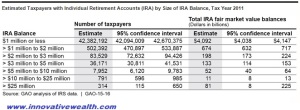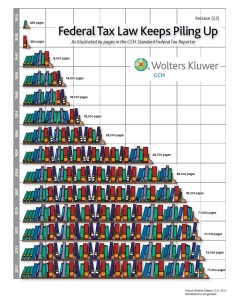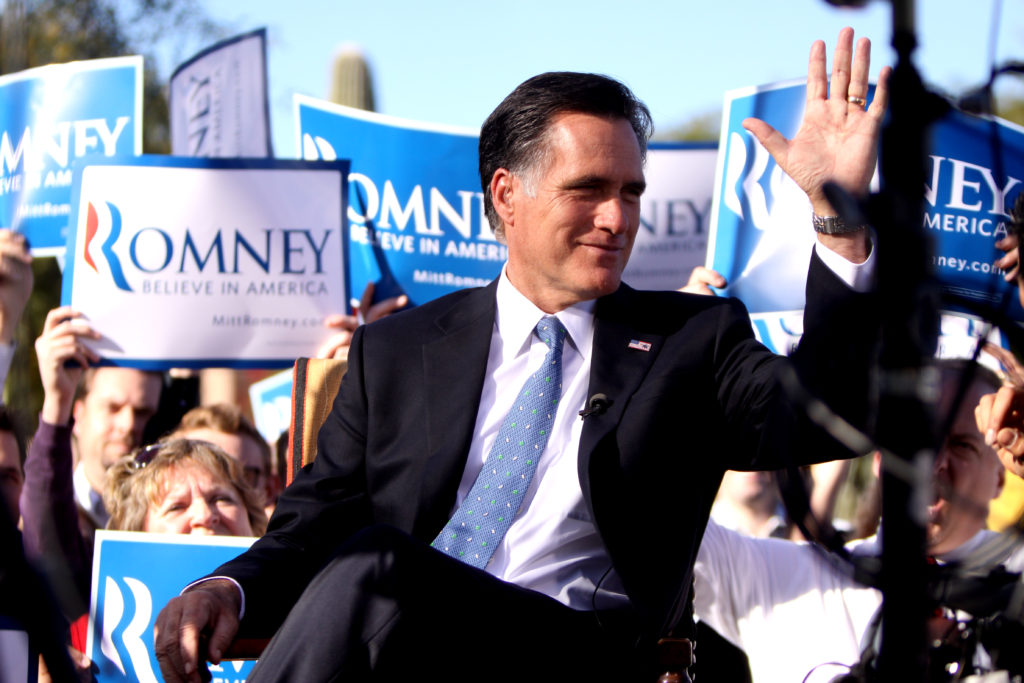The Big IRA and the recent Government Accountability Office report
In 2012, during the presidential election campaign between Barack Obama and Mitt Romney, the issue was raised about Mitt Romney’s over-sized IRA. At one point the Mitt Romney IRA is reported to have had as much as $102,000,000 in it. Yes, you read that correctly.
Mitt Romney’s IRA was worth $102,000,000.
Even compared to his reported $250 million net worth, this is a sizable chunk of capital to have accrued in his IRA given his approximate 40 years of working experience. How did he do it?
The recent Government Accountability Office report

In October 2014, the U.S. Government Accountability Office (GAO) released a report, Individual Retirement Accounts – IRS could bolster enforcement on multi-million dollar accounts, but more direction from congress is needed. According to the GAO, they found that there were 314 taxpayer IRAs that had an account balance of over $25,000,000 and 791 taxpayers with balances between $10,000,000 and $25,000,000. That is a total of 1105 people who have been great investors, extremely lucky, or both. Either way, they have found a way to capitalize on the tax benefits of a Traditional IRA or Roth IRA by growing their capital in a tax-deferred or tax-free manner.
While it may not be easy to accumulate over $100 million in your IRA, you can still use the same strategies that Mitt Romney used to accumulate a sizable IRA account balance.

How did Mitt Romney’s IRA grow so big?
The rules outlined in the Internal Revenue Code (IRC) specifically detail what can and cannot be done with a self-directed IRA. As long as these rules are followed, the owner of the IRA can invest in virtually any investment or investment strategy they want. In the case of Mitt Romney, his background is in private equity. He would have access to a lot of different deals through his former company that most investors would not have access to.
Most likely Mitt took advantage of his knowledge and understanding of investing in private companies and used it to benefit his IRA. Unless Mitt chooses to disclose what his actual investments were and the specific strategies he used to grow his IRA, we will not get a direct insight into exactly how he did it. However, the strategies many people use to invest their IRA in a similar manner as I suspect Mitt did, involve a lot of creativity. I suspect that creativity was involved in addition to his obviously successful investments.
Did Mitt Romney do something illegal?
As I stated above we will never know the details unless Mitt Romney or the IRS chooses to disclose the activities of his IRA, however, I can tell you that what he did to grow his IRA that big was entirely possible through legal means. Although I won’t discuss all of those secrets here in this article (Our firm does provide this self-directed IRA service for our clients), you should know that if you want to invest in alternative investments such as private company stock, real estate, intellectual property, physical gold, or other non-traded assets with your IRA, it is entirely possible as long as you follow the rules outlined in the Internal Revenue Code.

Did Mitt Romney have “special” insider information that no one else had?
In addition to Mitt Romney, Peter Thiel, famed venture capitalist and co-founder of Paypal is reported to have invested in Facebook stock when it was a private company through his Roth IRA. He is another example of someone growing his IRA due to his specialized knowledge. According to this GAO report, there are 312 additional taxpayers with IRAs above $25,000,000.
If one of these 314 lucky/smart people had used their Traditional IRA, they (or their heirs) would have to eventually pay taxes on the distributions from that IRA as income. However, if they used their Roth IRA, the distributions would be tax-free. It is doubtful that these 314 people spent their days reading through the 73,954 pages of the US federal tax code (sup) for fun, and just coincidentally came across these secrets. It is more likely that one of their financial advisors told them about this secret. This is why it is extremely important to have access to some of the top financial advisors on Wall Street. Having top financial advisors has allowed investors such as these, access to valuable information that most people are not aware of.
How can you use this “secret” information in the Internal Revenue Code to help you use the same strategies which are available to Mitt Romney and Peter Thiel?
Having an IRA in excess of $25,000,000 requires a lot of things to go right. It requires access to good investments with the potential for high returns, and it also requires a lot of luck. This is the case for most investments, but especially so for IRAs in excess of $100,000,000.
There are 6 major factors that would be necessary to grow your IRA to an extreme end of the spectrum such as having a valuation of $100,000,000. The insight is most likely well-known to Mitt Romney and Peter Thiel, and the other 312 in the “ Big IRA” club:
- Access to good investments with the potential for high returns;
- Having Lady Luck on speed dial;
- Tax-free or tax-deferred growth;
- Invest in what you know;
- Time;
- Creativity and access to specialized knowledge.
People like Warren Buffett, Carl Icahn, and Jim Rogers have a solid track record of long periods of success. They know secrets to grow their wealth beyond what most people are capable of. Mitt Romney and Peter Thiel have a similar track record. They have managed to aggregate all 6 of these factors together to amplify their returns inside their retirement account, which provides them tax-deferred or tax-free growth of their retirement funds.
Who does this investment strategy work best for?
Based on the case studies presented about Mitt Romney and Peter Thiel, this is a great investment strategy for entrepreneurs, venture capitalists, private equity, and hedge fund investors. Mainly, people who have access to solid investments with the potential for high returns. They can then add these investments to their IRA in a tax-deferred or tax-free environment. While this strategy works well for other types of investors, such as people focused on real estate, intellectual property, and private lending, it is best suited for people with high visibility into good investments.
Just because you may not work at a hedge fund, a private equity firm, or some other financial service company with access to good investments, does not mean you cannot take advantage of this secret strategy. Even people with IRAs under $1,000,000 (98.5% of taxpayers) can benefit from a self-directed IRA. This strategy is not limited to the mega-wealthy.
Growing a “Big IRA” is not as easy as it may seem for most people
Many of the articles I have read about Mitt Romney and Peter Thiel’s large IRAs have alluded to these two people and others, having some advantage over other people. I would stipulate that the only advantage they have over other people is that they knew the rules outlined in the Internal Revenue Code, and they chose their investments wisely. While there are some other “tricks” that could be used legally to amplify investment returns, the 6 key factors above are very important components in growing a big IRA.
It is clear that individual investors do not have a good track record of investing. I pointed out this fact in my recent post, Why are individual investors so bad at investing? Common problems that many investors have are:
- lacking the patience to allow their investment to grow,
- not being in control of their emotions,
- trying to “gamble” rather than invest their capital in long-term investments, and
- investing in assets they are not an expert in.
It is not a surprise that someone with resources, access to high-quality investments, and a solid investor acumen was able to grow their IRA to $100 million. Although I can’t say specifically how each of these people grew their IRAs as large as they did. I can say generally how it was done since we frequently use strategies like this, which could allow people to amplify their returns in a similar manner.
Here are some simple examples of how you can use your expertise, time, and tax-deferred growth to grow your IRA to $100,000,000.
Example 1: Contribute $10,000 annually to your IRA for 20 years, then compound those funds at 50% annually.
Example 2: Contribute $50,000 annually to your IRA for 20 years, then compound those funds at 37% annually.
Example 3: Contribute $25,000 annually to your IRA for 37 years, then compound those funds at 19.1%
While these examples might seem incomprehensible to most people, there are investments that can produce those types of returns. They are obviously harder to find. For reference, Warren Buffett had an average return over 48 years of 19.7%, and his returns were partially taxable. If you had invested $25,000 in Berkshire Hathaway with Warren Buffett for 42 years (ending in 2013), and with no additional contributions to your IRA during that period, you would have also reached the $100,000,000 mark.
How can you use this big IRA “secret” to grow your retirement funds?
While I won’t disclose all the “secrets” Mitt Romney and Peter Thiel used, which you could also use to help amplify your returns in your IRA, I can tell you that it can be done legally. I can also tell you that there is no “one” way to do what they did. Creativity plays a large part of the process. This strategy is not a silver bullet or a quick fix solution that can be quickly learned, it must be done through a consultative approach.
If you want to learn more about how you can use your Traditional IRA or Roth IRA in a similar manner as Mitt Romney or Peter Thiel, you can reach us at Innovative Advisory Group. You can also find some great resources about self-directed IRAs here.
Sources:
Bloomberg
CCH Standard Federal Tax Reporter
Berkshire Hathaway Annual Reports
About Innovative Advisory Group: Innovative Advisory Group, LLC (IAG), an independent Registered Investment Advisory Firm, is bringing innovation to the wealth management industry by combining both traditional and alternative investments. IAG is unique in that they have an extensive understanding of the regulatory and financial considerations involved with self-directed IRAs and other retirement accounts. IAG advises clients on traditional investments, such as stocks, bonds, and mutual funds, as well as advising clients on alternative investments. IAG has a value-oriented approach to investing, which integrates specialized investment experience with extensive resources.
For more information, you can visit www.innovativewealth.com
About the author: Kirk Chisholm is a Wealth Manager and Principal at Innovative Advisory Group. His roles at IAG are co-chair of the Investment Committee and Head of the Traditional Investment Risk Management Group. His background and areas of focus are portfolio management and investment analysis in both the traditional and non-traditional investment markets. He received a BA degree in Economics from Trinity College in Hartford, CT.
Disclaimer: This article is intended solely for informational purposes only, and in no manner intended to solicit any product or service. The opinions in this article are exclusively of the author(s) and may or may not reflect all those who are employed, either directly or indirectly or affiliated with Innovative Advisory Group, LLC.

